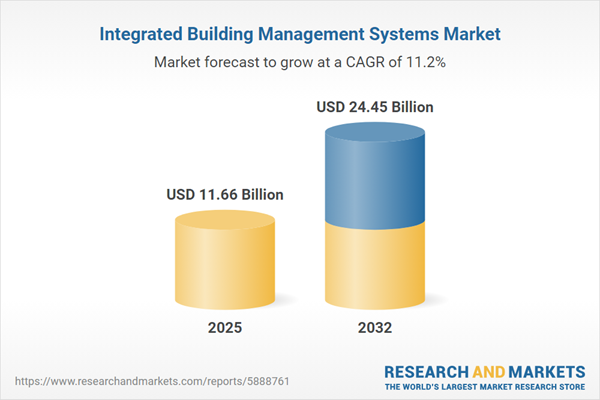Speak directly to the analyst to clarify any post sales queries you may have.
Integrated Building Management Systems (IBMS) are driving a fundamental shift in how facilities are governed across organizations worldwide. These unified platforms enable streamlined control, automation, and compliance, providing senior leaders visibility and agility across increasingly sophisticated real estate portfolios.
Market Snapshot: Integrated Building Management Systems
In 2024, the global IBMS market reached a valuation of USD 10.46 billion, supported by an 11.19% compound annual growth rate. Projections show the market will achieve USD 11.66 billion in 2025 and expand to USD 24.45 billion by 2032. This accelerated growth is propelled by automation and digital transformation across key sectors, including real estate, healthcare, and manufacturing. Organizations turn to IBMS to harness real-time analytics and advanced energy management, responding to demands for heightened compliance, sustainability, and operational efficiency. Enhanced data portability and compatibility allow companies to expedite investment decisions, improve process flows, and strengthen regulatory readiness.
Scope & Segmentation of the Integrated Building Management Systems Market
- Component Types: IBMS solutions combine advanced controllers, sensors, gateways, actuators, and centralized software, each facilitating energy efficiency, cybersecurity, and holistic facility management. Professional services such as consulting, system integration, deployment, and support further increase performance and optimize returns.
- Applications: Addressing a range of needs, IBMS platforms provide solutions for energy management, lighting optimization, HVAC control, access management, fire detection, intrusion prevention, and video monitoring. These capabilities ease regulatory compliance and reinforce business continuity as well as building occupant safety.
- End Users: Deployments span office complexes, healthcare institutions, hospitality venues, retail outlets, manufacturing sites, data centers, utilities, public sector facilities, laboratories, and residential buildings. Segmentation allows adaptation to specific operational needs and sector risk profiles.
- Communication Types: Adoption of wired protocols (including BACnet IP, MS/TP, LonWorks, Modbus) and wireless options (such as EnOcean, Wi-Fi, WirelessHART, Zigbee) enables seamless integration with both legacy and newer building assets, supporting secure and streamlined operations.
- Deployment Modes: Cloud-based and on-premises configurations cater to varying organizational security and infrastructure requirements, promoting scalability and compliance across different IT environments.
- Regions: IBMS implementation is global, encompassing territories in the Americas, Europe, Middle East, Africa, and Asia-Pacific. Regional adoption is influenced by factors such as infrastructure advancement, regulatory environment, climate imperatives, and policy standards. Markets including the United States, Germany, China, and India are notable for leading innovation and uptake.
- Companies Covered: Major providers are Schneider Electric SE, Johnson Controls International plc, Siemens AG, Honeywell International Inc., ABB Ltd, Carrier Global Corporation, Trane Technologies plc, Delta Electronics, Acuity Brands, and BuildingIQ, all focusing on continuous solution refinement to meet evolving needs.
Integrated Building Management Systems: Key Takeaways for Decision-Makers
- IBMS platforms unify management of widespread facilities, allowing integration across both older and newer systems for cohesive oversight.
- Edge computing, AI, and digital twin technologies are enhancing predictive maintenance, reducing risk, and optimizing performance via analytics-driven strategies.
- Cloud-based and on-premises IBMS options offer agile adaptation, helping organizations address shifting compliance demands and align with diverse IT infrastructures.
- Reliance on standards-based protocols expedites system implementation while minimizing dependence on proprietary platforms.
- Effective cybersecurity policies and ongoing staff training increase the protection and resilience of interconnected building environments.
- Sector objectives differ, with commercial environments prioritizing occupant well-being, manufacturers focusing on operational continuity, and government entities emphasizing secure, sustainable practices.
Tariff Impact on Supply and Strategy
Recent updates to US tariff regulations have driven organizations to reevaluate procurement and supplier relationships. Many now opt for local or regional sourcing and modular IBMS architectures, improving supply chain resilience, ensuring greater system reliability, and reducing exposure to market fluctuations.
Methodology & Data Sources
This research draws from direct engagement with facility executives, building management professionals, solution vendors, and regulatory leaders. Both primary interviews and industry studies inform the analysis, delivering an accurate reflection of current trends, challenges, and best practices in the IBMS ecosystem.
Why This Report Matters
- Equips executives with frameworks for scaling IBMS strategies that meet compliance and operational demands in changing regulatory climates.
- Delivers actionable market segmentation and insights to guide investments, strengthen risk management, and support sustainability initiatives across high-value properties.
- Enables evidence-driven technology and supplier decisions with validated data and assessment methodologies tailored for enterprise objectives.
Conclusion
IBMS platforms position organizations to achieve higher efficiency, resilience, and adaptability while streamlining their response to shifting regulatory and technology requirements.
Additional Product Information:
- Purchase of this report includes 1 year online access with quarterly updates.
- This report can be updated on request. Please contact our Customer Experience team using the Ask a Question widget on our website.
Table of Contents
3. Executive Summary
4. Market Overview
7. Cumulative Impact of Artificial Intelligence 2025
Companies Mentioned
The companies profiled in this Integrated Building Management Systems market report include:- Schneider Electric SE
- Johnson Controls International plc
- Siemens AG
- Honeywell International Inc.
- ABB Ltd
- Carrier Global Corporation
- Trane Technologies plc
- Delta Electronics, Inc.
- Acuity Brands, Inc.
- BuildingIQ, Inc.
Table Information
| Report Attribute | Details |
|---|---|
| No. of Pages | 199 |
| Published | October 2025 |
| Forecast Period | 2025 - 2032 |
| Estimated Market Value ( USD | $ 11.66 Billion |
| Forecasted Market Value ( USD | $ 24.45 Billion |
| Compound Annual Growth Rate | 11.1% |
| Regions Covered | Global |
| No. of Companies Mentioned | 11 |









